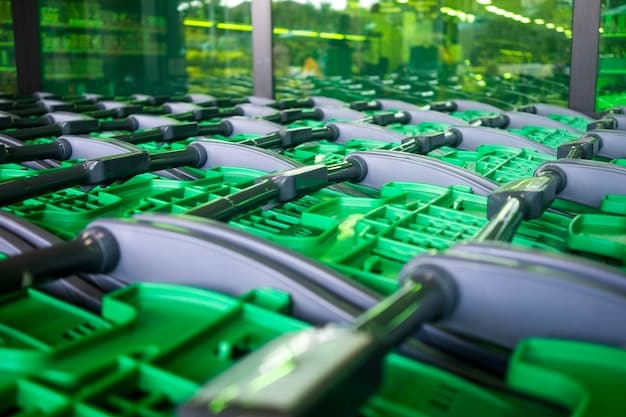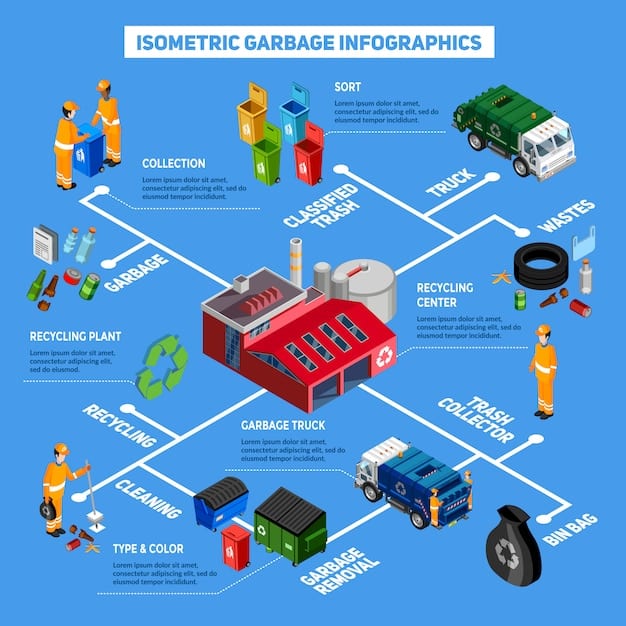Electric Vehicle Battery Recycling Breakthrough: 95% Material Recovery by 2026

Electric Vehicle Battery Recycling Breakthrough: New Technology Promises 95% Material Recovery by 2026, marking a significant leap towards sustainable electric vehicle production by drastically reducing reliance on raw material extraction and minimizing environmental impact.
The electric vehicle revolution is gaining momentum, but what happens to all those batteries at the end of their life? A groundbreaking development promises to revolutionize the industry: a new technology aiming for Electric Vehicle Battery Recycling Breakthrough: New Technology Promises 95% Material Recovery by 2026. The focus turns to sustainability and minimizing environmental impact in the electric vehicle industry.
Electric Vehicle Battery Recycling: Why it Matters
The increasing popularity of electric vehicles (EVs) brings with it a significant challenge: what to do with the batteries at the end of their lifespan? The current methods of battery disposal and recycling are not sufficient to handle the projected volume of end-of-life EV batteries.
Traditional methods often involve incineration or landfilling, which pose environmental risks due to the release of harmful chemicals and heavy metals. Moreover, these approaches fail to recover valuable materials present in EV batteries, such as lithium, nickel, and cobalt.
The Growing Need for Efficient Recycling
As the number of EVs on the road continues to grow exponentially, the demand for critical battery materials is also surging. Extracting these materials from the earth through mining has its own environmental and social costs, including habitat destruction, water pollution, and community displacement.
Efficient EV battery recycling is crucial for creating a circular economy for battery materials, where valuable resources are recovered and reused, reducing the need for mining and minimizing the environmental footprint of EV production.
- Reduces reliance on raw material extraction.
- Minimizes environmental impact from mining.
- Conserves valuable resources.
- Supports a circular economy for battery materials.
Efficient electric vehicle battery recycling is not just an environmental imperative; it’s also an economic opportunity. By recovering valuable materials from end-of-life batteries, we can create a sustainable supply chain and reduce our dependence on foreign sources for critical battery components.

The Technological Breakthrough: 95% Recovery
The headline-grabbing promise of a new electric vehicle battery recycling technology achieving 95% material recovery by 2026 is not mere hype; it represents a tangible advancement with real-world implications. This leap in efficiency could redefine the economics and environmental impact of EV battery management.
This technological breakthrough addresses the limitations of existing recycling methods, offering a more comprehensive and environmentally friendly approach to recovering valuable materials from spent EV batteries.
How Does it Work?
While the specific details of the technology may vary, the general approach often involves a combination of mechanical, chemical, and hydrometallurgical processes. These processes are designed to separate the different components of the battery and recover the valuable materials in a high-purity form.
Advanced technologies, such as direct recycling, can recover cathode materials directly without breaking them down to their constituent metals. This approach can significantly reduce energy consumption and waste generation compared to traditional methods.
Regardless of the exact methods used, the goal remains the same: to maximize the recovery of valuable materials while minimizing environmental impact.
- Mechanical separation to dismantle the battery.
- Chemical treatments to dissolve and separate materials.
- Hydrometallurgical processes to recover high-purity metals.
A successful breakthrough achieving such a high recovery rate would address some of the biggest criticisms about EVs, turning battery disposal from an environmental liability to a sustainable resource.
Impact on the Electric Vehicle Industry
The promise of 95% material recovery in electric vehicle battery recycling has the potential to drastically alter the landscape of the EV industry. This isn’t just about cleaning up the tail end of the product lifecycle. It’s about creating a more sustainable, resilient, and economically viable ecosystem for electric mobility.
High recovery rates can significantly reduce the cost of producing new EV batteries. The recovered materials would offset the need for newly mined materials, which are often subject to price volatility and geopolitical instability. The benefit to the industry is far reaching.
Lower Battery Costs
The cost of EV batteries is a major barrier to wider adoption. Recovering valuable materials from end-of-life batteries can significantly reduce the cost of producing new batteries, making EVs more affordable for consumers.
By reducing the reliance on newly mined materials, battery manufacturers can insulate themselves from price fluctuations and supply chain disruptions, leading to greater price stability for EV batteries.
A More Sustainable Supply Chain
Currently, the supply chain for battery materials is often opaque and fraught with environmental and social concerns. High-efficiency recycling can create a more transparent and sustainable supply chain, reducing the industry’s reliance on conflict minerals and environmentally damaging mining practices.
This transition is essential for building consumer confidence in the long-term viability of electric vehicles and ensuring that the benefits of electrification are not offset by environmental and social costs elsewhere.

Challenges and Obstacles
While the prospect of 95% material recovery from EV batteries is promising, it’s crucial to acknowledge the challenges and obstacles that stand in the way of widespread implementation. These challenges include technological hurdles, economic considerations, and regulatory frameworks.
Scaling up new technologies from the laboratory to commercial operations is never easy. Ensuring that the recycling process is economically viable is also crucial for attracting investment and driving adoption.
Technological Hurdles
Achieving consistently high recovery rates across different battery chemistries and designs is a significant technical challenge. EV batteries come in various shapes, sizes, and compositions, requiring flexible and adaptable recycling processes.
Developing cost-effective and environmentally sound methods for separating and purifying the recovered materials is also essential. The presence of contaminants can significantly reduce the value of the recovered materials and hinder their reuse in new batteries.
Economic Considerations
Recycling EV batteries can be an expensive endeavor, especially when dealing with complex battery designs and low volumes. Making the recycling process economically viable requires optimizing the process, reducing costs, and creating a market for the recovered materials.
Government incentives and regulations can play a crucial role in leveling the playing field and encouraging investment in EV battery recycling infrastructure.
- Varying battery chemistries require different recycling processes.
- High initial investment in recycling infrastructure.
- Ensuring economic viability in a competitive market.
Overcoming these challenges will require collaboration between researchers, industry players, policymakers, and consumers. By working together, we can create a sustainable and responsible EV battery recycling ecosystem.
Government Regulations and Incentives
The path towards widespread electric vehicle battery recycling relies not only on technological advancements, but also on supportive government regulations and incentives. These policies can create a level playing field, encourage investment, and drive innovation in the recycling industry.
Many countries are now developing regulations that mandate or incentivize battery recycling. These policies may include targets for material recovery, extended producer responsibility schemes, and financial incentives for recyclers.
Extended Producer Responsibility (EPR)
EPR schemes hold battery manufacturers responsible for the end-of-life management of their products. This approach encourages manufacturers to design batteries that are easier to recycle and to invest in recycling infrastructure.
EPR can also create a more level playing field by ensuring that all manufacturers contribute to the cost of recycling, rather than leaving it to taxpayers or municipalities.
Financial Incentives
Financial incentives, such as tax credits, subsidies, and grants, can help to offset the costs of building and operating EV battery recycling facilities. These incentives can also encourage consumers to return their end-of-life batteries for recycling.
Well-designed incentives can accelerate the development of a robust and competitive EV battery recycling industry, driving innovation and reducing the environmental impact of EVs.
| Key Point | Brief Description |
|---|---|
| ♻️ High Recovery | Technology aims for 95% material recovery by 2026. |
| 💰 Cost Reduction | Recycled materials lower new battery production costs. |
| 🌎 Sustainability | Less mining and a greener supply chain for EVs. |
| 📜 Regulations | Government policies support recycling efforts. |
Frequently Asked Questions
▼
It represents a major step towards a circular economy for EV batteries, reducing reliance on mining and minimizing environmental impact. This milestone promotes sustainability and reduces the consumption of raw materials.
▼
Key materials include lithium, nickel, cobalt, manganese, and aluminum. These metals are crucial for producing new batteries and other industrial applications, improving resource management.
▼
By reducing the need for newly mined materials, the cost of producing new EV batteries can be significantly lowered. This could lead to more affordable EVs for consumers, making them more accessible.
▼
Recycling reduces the environmental damage caused by mining, conserves valuable resources, and prevents hazardous materials from ending up in landfills. It is better for the environment and better for the world.
▼
Governments can implement regulations, offer financial incentives, and support research and development to promote battery recycling. Their support is essential for creating a robust, sustainable framework and industry.
Conclusion
The electric vehicle battery recycling breakthrough, promising 95% material recovery by 2026, presents a paradigm shift in the EV industry, addressing sustainability concerns, reducing reliance on raw materials, and paving the way for a more environmentally responsible and economically viable future for electric mobility.
“`





